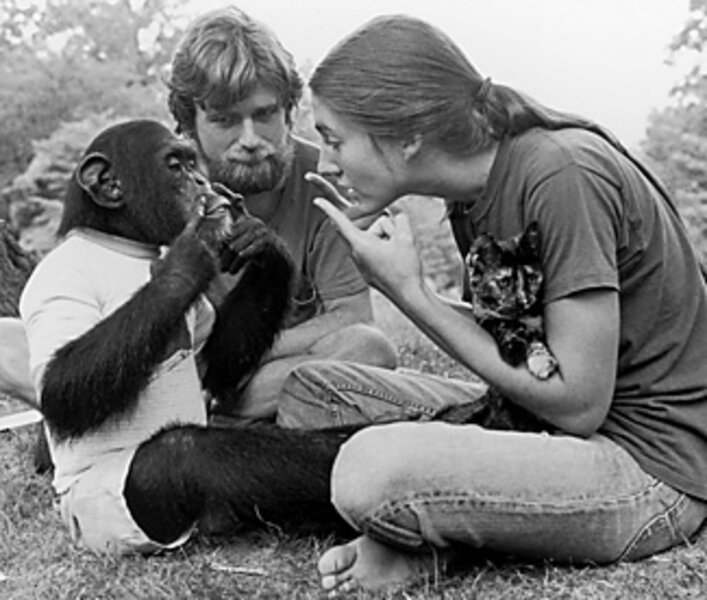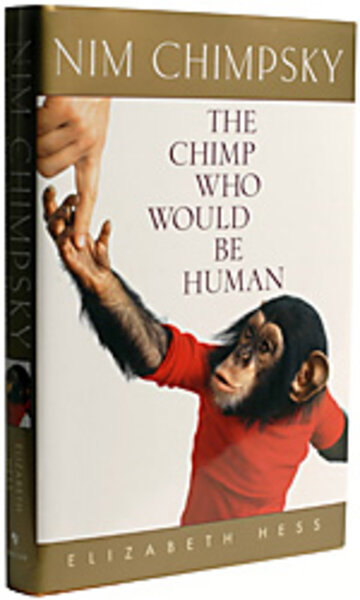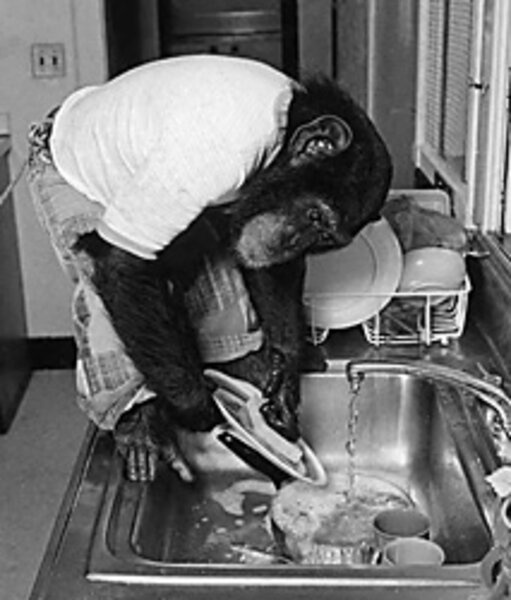What 'Nim Chimpsky' taught them all
Loading...
It was the early 1970s, an era of experimentation. Minds were open and grants were plentiful at the moment that scientists latched onto the idea of raising baby chimpanzees as humans and teaching them sign language. After all, if they succeeded they might penetrate the mysteries of the animal mind. And if not, what was the harm?
Plenty, as journalist Elizabeth Hess demonstrates in Nim Chimpsky: The Chimp Who Would Be Human, her nonfiction account of the most famous of several chimps raised by human families for scientific purposes.
Nim did learn to use 150 characters of American Sign Language (ASL) and to the end of his days he was apt to contritely sign "sorry" if he bit or hurt someone. (And in his last years he became a tutor, teaching basic signs to fellow chimps and cagemates.)
But if scientists hoped to deepen interspecies understanding, then most of what they learned from Nim was how much they didn't know. As a result, they grossly underestimated the difficulties of working with a chimp and, tragically, entirely failed to grasp the depth of his emotional needs.
"Nim Chimpsky" is about as poignant an animal story as you can get. The neglect Nim suffered (most of which was inadvertent) is heartbreaking. And yet in many ways reading about him remains a joyous experience. Nim was an unforgettable character – affectionate, mischievous, empathetic, and utterly charming. People who knew him could never stop loving him.
"I thought about him every day," says his human "sister" 30 years after parting from him. "I still do." Nim was born in 1973 in a research facility in Norman, Okla. Ten days later he was taken from his mother and given to the LaFarges, a wealthy family living in a brownstone in New York City. There, Nim was a happy fellow, frolicking with the LaFarge children in his tiny overalls, developing a taste for ice cream and pizza, and bonding deeply with his people.
His "mother," Stephanie, recalled years later that if she cried in his presence he would bring her a tissue. She remembered his eyes as "large and wide" with "a gravitas and depth that were haunting."
But Nim had work to do. His sponsor was a Columbia University professor to whose lab he commuted daily. There, he was expected to sit at a desk and memorize ASL signs. (Nim's name was a defiant sneer at linguist Noam Chomsky, who believed the use of language was unique to humans. The whole point of Project Nim was to prove Chomsky wrong.)
But Nim was not always successful or cooperative. When the LaFarges decided they couldn't keep him any longer, it was just the first in a series of abandonments for Nim. Unfortunately, while busy bonding Nim to humans, no one had stopped to think of how hard it might be to someday undo those attachments.
Nim was not the only chimp to experience such loss. Hess tells the stories of other chimps placed with human families at the same time Nim was. Many sickened and one even died when separated from their human "parents."
In "Nim Chimpsky" Hess does a good job of rolling any number of stories into one. She vividly recreates the key animals and people in Nim's life. While readers interested only in Nim may occasionally get impatient, for the most part these narrative detours are fascinating, and together they bring to life a world that kept shifting around Nim.
Divorce, academic disgrace, and infighting had nothing to do with him yet all these contributed to the erosion of his quality of life.
Eventually, he became too difficult to maintain outside a cage, even as he failed to decisively disprove Chomsky. Nim, who had been tucked into his own bed each night by loving humans was now sleeping on a cement floor with other chimps.
But the worst was yet to come. When grant money ran dry, Nim was shipped to a medical lab, useful now only as a test subject for vaccines – until his high-profile rescue by animal-loving celebrity Cleveland Amory.
Hess has written about animals and their advocates before ("Lost and Found: Dogs, Cats, and Everyday Heroes at a Country Animal Shelter.") She is clearly an animal lover, yet (with a few exceptions) she resists the temptation to demonize the humans in Nim's life.
Nim was gregarious. He relished human companionship all his life. In his last decade (spent caged in a sanctuary) he also bonded with fellow chimps. He died in 2000 at age 26, about 20 years earlier than would be normal for a chimp.
At Nim's memorial service, the sanctuary caretaker spoke of the profound affection his whole staff had for Nim – how he would play jokes on them, draw pictures for them, sign to them, or steal their shoes (his particular fetish).
It's only too easy to imagine how deeply all the humans touched by him must have missed him. And readers, too, will find that Nim haunts them long after they close the pages of this book.
[Editor's note: The original version identified Nim as a monkey instead of a chimp. (Chimps are apes, not monkeys.)]
• Marjorie Kehe is the Monitor's book editor. Send comments to kehem@csps.com







